[mashshare]
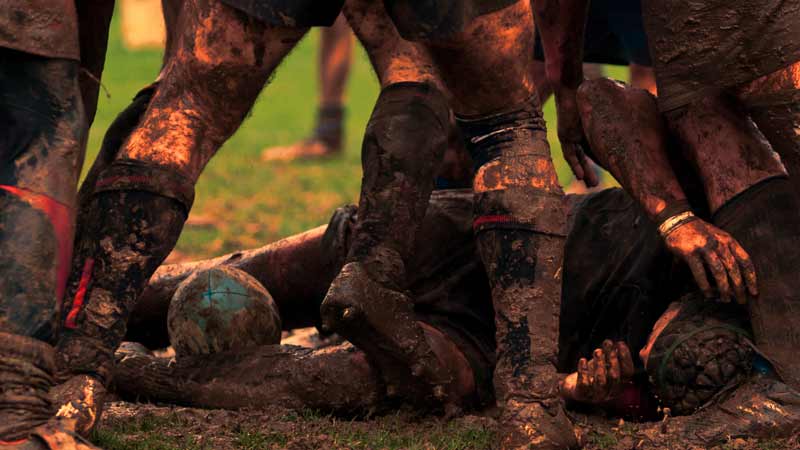
Introduction
Field sports are sports such as soccer, rugby union and rugby league, Australian Rules football (AFL), Gaelic football and field hockey. They are characterized by a somewhat stop-start nature, varying movement speeds, multiple changes of direction and the execution of decisions and individual skills under conditions of game pressure and/or fatigue and in the case of some of those sports, the threat of imminent collisions. The nature of the movements in these sports requires the utilization, and therefore training, of all three energy systems (ATP-PC, Glycolitic/Lactic acid and Aerobic systems). However despite the often stop-start nature of these sports, which heralds an increase in anaerobic energy contributions (10), high-intensity aerobic power and conditioning can be critical for success in field sports (4).
The purpose of this article is to detail a number of methods to develop high intensity aerobic conditioning and describe the practical implementation and integration of these methods into the Preparation Period training for field sport athletes.
Recent applied research in aerobic training for field sports
Much research is now focused on Maximal Aerobic Speed (MAS). Research shows that the amount of time spent at or above the 100% Maximal Aerobic Speed (MAS) appears to be the critical factor for improving aerobic power (5-15).
It has been determined that performing a number of short intervals at > 100% MAS was a more effective method of building aerobic power than the more traditional Long Slow Distance (LSD) training (14) (i.e. going for long road runs etc) or than attempting to train only one interval continuously at 100% MAS (13).
Specifically, an intensity of 120% MAS was determined to be the best single speed for short intervals that are followed by a short respite (passive rest) interval, based upon the fact that this intensity allowed the greatest supra-maximal training impulse (intensity x volume), in comparison to 90, 100, and 140% MAS (13). Especially intervals of 120% MAS for 15-30 seconds followed by an equal respite interval of passive rest and continuing on for 5-10 minutes.
A Japanese researcher called Tabata (14) also found that athletes working at 170% VO2 Max (the % MAS was not reported) for 20 seconds followed by 10 seconds passive rest and continuing on this manner for 4-minutes produced excellent changes in aerobic and anaerobic power, better than performing LSD training sessions of 60-minutes at 70% MAS. However, the high intensity group also improved 28% in anaerobic performance while the low intensity group was unchanged. Accordingly, given the greater results and less time investment, it was considered that the high intensity training was much more efficacious than LSD training. This type of training is typically now known as the Tabata method.
The basis of all this recent research is that high intensity intervals of 15-30+ seconds, interspersed with 10-30 seconds of either low intensity active recovery (eg. < 40-70% MAS) or passive rest, continued in this manner for total set times of 4-10 minutes and repeated for 2 or more sets greatly enhances aerobic power and capacity.
It didn’t matter much if it was 20 seconds work, 10 seconds recovery, 30:15, 15:15, the research has kept pointing to the fact that training at or above 100% MAS was the key intensity parameter and how long you spent there was the driving volume parameter under-pinning improvements in aerobic power.
Consequently high-intensity interval training using intensities of 100% MAS to develop the ability to sustain high intensity efforts or intervals at 120%+ MAS to develop higher levels of MAS or enhance the ability to repeat high intensity efforts appear to be increasingly used in the training of field sport athletes (e.g. 1-15). The practical implementation of a number of these methods will be detailed below.
But what about the polarity of aerobic training? Isn’t that how the endurance athletes are training?
While true aerobic endurance athletes (e.g. distance runners, cyclists, triathletes etc) talk about the effectiveness of the polarity of training (using predominantly LSD < 85% MAS, with a portion, say 20%, of very high intensity training >92% MAS), it must be remembered that for field sport athletes, practical observation has shown that most of the skill and tactical training undertaken are at LSD type of speeds and heart rates. Thus, given that skill and tactical training with the sports coach is the major form of training performed by field sport athletes for most of the season and this training involves cardio-vascular stimulation at the lower end of the “polarity spectrum”, the role of the strength and conditioning coach is to provide a high-intensity stimulus to improve aerobic fitness.
I will give you an example. When I worked in professional rugby league, over the last few years all the players wore GPS for every field training session and for games. We know that in games the players, depending upon their position and role, cover about 100-110 m/minute. This is similar in soccer but AFL football average about 125-145+ m/min because they are allowed over 100 substitutions per game, so they go hard and then get subbed off for a short respite before doing it again.
But what distances do field sport athletes cover in skill/tactical sessions? Typically from my sport of NRL rugby league it is about 55-65 m/min (this is lower than soccer and AFL training sessions but in NRL the nature of the games are collisions etc). Typically performed skill and tactical training does not improve fitness but in its way it provides the polar opposite to the high intensity aerobic training I am about to discuss and it constitutes the vast majority of the training week for field sport athletes. Therefore when a strength & conditioning coach has access to the players for conditioning, they must utilize high-intensity methods, with relative velocities of 140-160+m/min (this is inclusive of the rest periods, so for example 15-sec at 5 m/s followed by 15/sec rest x 2 = 150 m/min). This then is the polarity of their training for field sport athletes – mostly the skill and tactical work is done at low intensity, so the specific conditioning must be done at high intensity.
Field testing of MAS – Measuring Maximal Aerobic Speed (MAS)
There is some controversy about how to measure MAS for field sports (4). The MAS is physiologically defined as the lowest speed at which VO2 maximum (VO2 max) has occurred. In a laboratory this is measured with gas analysis while running on a treadmill, according to a number of accepted routines. However, some athletes can still run slightly faster than the first speed at which VO2 maximum has occurred without any change in VO2max ~ so there can be a slight difference in speeds at which VO2 max is occurring (but physiologically, the lowest speed at which VO2max occurred is the definition of MAS). This fact is one of the many confounding factors that sometimes cloud the issue of measuring MAS in athletes for the purpose of diagnosis and training prescription. Other simple ones include differences between treadmill running and running on a sports field!
Nonetheless for field sports, MAS should be assessed during running based tests. Over the years a number of simple running-based field based tests have been developed that correlate with MAS measured via the treadmill/gas analysis method(s). Some field tests are continuous, some are intermittent, some are linear running, some are shuttle-based running, some are incremental and some are steady-paced.
The most common field tests of MAS include the Montreal Beep test, the Multistage Shuttle Beep test, the YoYo IR1 test, time trials with set times (eg. 5-minutes or 6-minutes) or set distances that take the athletes between 5- to 7-minutes to complete (eg. 1200-m, 1500m, 2000-m). Some of these tests have been further modified, such as the Montreal test being altered to include 1-minute stages, rather than 2-minute stages and so on.
The choice of tests and their merits sometimes cloud the issue of measuring MAS in athletes and the pro’s and cons of each method is not the scope of this article.
In certain tests, the MAS is simply the speed attained in the final leg of the test eg. Montreal Beep test or YoYo IR1 test. However if the Multistage Shuttle Beep test is used, then this equation:
must be used to correct for the fact that the constant decelerations involved with shuttling/change of directions reduces the true MAS (8).
These tests give results expressed as km/hr, which will then need to be converted to m/s so that training distances can be easily calculated. For example, Level 12 Multistage Beep, = 14 km/hr * 1.34 = 18.86, minus 2.86 then equals 15.9 km/hr or 4.4m/s.
For a set-time trial MAS test, for example, a 5-min time running trial, determining the average speed is a simple process (eg. 1320 meters divided by 300 s = 4.4 m/s). The simple 5-minute time trial has been shown to correlate very highly (r = 0.94) with MAS (7).
If using set distances, the time taken to complete the distance should be between 5- to 7-minutes. For example, if an athlete ran 1400-m in 318-seconds, then the MAS would be 4.4 m/s.
So once MAS is determined, it is very easy then to prescribe training. An example of a simple 5-minute field test for a theoretical soccer team with disparate MAS scores is outlined in Table 1. Training prescription for the following methods will then be illustrated using these theoretical scores.
| Group | 5-min MAS Time Trial | 100% MAS | 120% MAS |
| 1 | 1420-1460 m | 4.8 m/s | 5.75 m/s |
| 2 | 1360-1400 m | 4.6 m/s | 5.5 m/s |
| 3 | 1300-1340 m | 4.4 m/s | 5.3 m/s |
| 4 | 1240-1280 m | 4.2 m/s | 5.1 m/s |
Different Methods of High-Intensity Training
Outlined below are a number of different methods that may be applicable to the training of high-intensity aerobic training for field sport athletes. They are presented in the order that they should be presented to the athletes.

Long Intervals
Long intervals (LI) of 60-seconds up to 5-minutes can provide a training impulse (volume x intensity) base before progressing to training of higher intensity. They are best used in the early Preparation period, because the underlying objective is to increase the volume of work performed at high intensity (> 92 % MAS) and as such may not integrate well with other training such as skill and tactical units. The lower the MAS score the athlete possesses, the more beneficial LI are as a training stimulus. Consequently, elite field sport athletes may spend less time (or even no time) performing LI as compared to developing or teenage athletes.
Typically these intervals would be completed at an intensity above critical speed (aka “anaerobic threshold” or about 85% MAS). The longer the interval, the lower the intensity, so 3-minutes @ 90-100% MAS may be a better upper limit of interval length. When performing multiple repetitions, it is very difficult to maintain a time limit of 66% of the interval best (ie. If an athlete can hold 100% MAS for 5-minutes in a one-off maximum effort test, they find it very difficult to perform multiple repetitions of 3-minute intervals at 100% MAS).
For LI the work:recovery ratios are typically above 1:1 (eg. 3:2) or, at 1:1. If the ratios go much more than 3:1, then typically for LI, the % MAS is reduced, to say <90%. As most LI are already just below the desirable 100% MAS, this is not a preferred prescription.
So 4-6 repetitions of 3-minutes at 95% MAS with a 2-minute recovery (1.5:1) or 90-s at 100% MAS with a 90-s recovery (1:1) are quite challenging prescriptions in the initial General Preparation Phase.
There may need to be variation in the length of LI’s and the scope for reducing LI length and slightly increasing % MAS clearly exists. For example, if LI were performed 3/wk, then one day may be:
- Day 1. (6 x 3-minute intervals at 92% MAS with 2-minute recoveries) x 2-sets,
- Day 2. (5 x 2-minute intervals at 96% MAS with 2-minute recoveries) x 2-sets, and
- Day 3. (4 x 90-seconds at 100% MAS with 90-second recoveries) x 2-sets, with 3-minute rests between sets on all days.
Thus the total training time for these three LI sessions (excluding warm-up etc) would be 63-minutes, 43-minutes and 27-minutes. In this scenario, the Day 1 session is of such magnitude and effort that realistically no other meaningful training in other units (eg. skill and team tactics) may be possible. However the Day 2 and 3 sessions, with reduced training impulse and duration, could involve other units such as skills or tactics as well as speed technique drilling before the start of the conditioning block. This is why this of type of training is really only recommended in the initial weeks General Preparation phase (unless the volume is severely curtailed).

Maximal Aerobic “Grids” Method
The Maximum Aerobic Grids Method is also termed the 100% MAS:70% MAS Method. Based upon French research, coaches have developed a system called (among other names) the Maximal Aerobic Grids (aka “boxes” or “rectangles” method). This entailed training initially with short intervals of 15-30 seconds at 100-110% MAS interspersed with 15-30 seconds of active recovery at 50-70% MAS, continuing on for 5-10 or more minutes.
For running training, implementing this method basically entails devising rectangular concentric grids of various dimensions that equal ~15-s at 100% MAS along the long side of the rectangle and 15-s at 70% MAS along the short side (see Figure 1). The fastest group are on the outside grid or running channel, with the slowest group along the inside grid. The coach can stand in the middle of the rectangle, but if two staff are available, one would monitor the finish point of each long side of the rectangle.
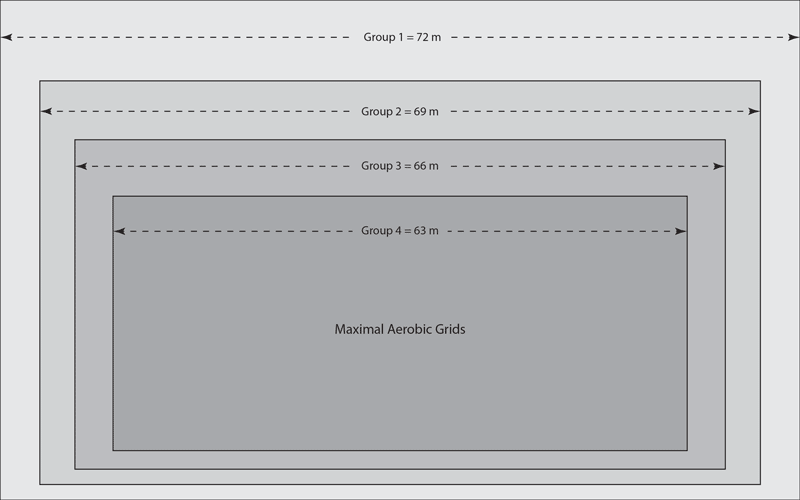
It can be seen from Figure 1 that a theoretical Group 1 runs 72 m in 15-s along the long side of the rectangle followed by 50 m along the short side and so forth. It takes 1 minute to complete one lap of the rectangular grid and this is completed without pause for 5-minutes initially and can be done for 2-4 sets with a 2-3 minute rest in between sets. The key point here is that each group has their grid based upon their own MAS capabilities ~ however, despite differences in MAS capabilities among large groups, each group should be at their respective corner of the rectangular grid each 15-s, which makes training compliance easy to monitor. The athletes are not allowed to speed up during the 70% sides to get a head-start on the harder sides – this just makes the grid an anaerobic threshold grid, something to avoid! This is enforced by making the athletes momentarily stop and hold the start position on the start of each long side of the grid.
When performing this drill, it is more practical to build up to 6, then 8-minutes and repeating for 2-4 sets (or build up to 10 minutes and performing 1-2 sets) rather than increasing the length of each 100% repetition to 30 s or more. It is difficult to do the running grids for 30s each side because you can physically run out of room to make a rectangle (eg. 30 s x 4.6 m/s means the long, 100% MAS side would have to be 138 m long, a distance which is hard to find on typical sporting fields).
Every 3-4 weeks it may be necessary to retest MAS or more simply to advance each group up to the next grid (which would be about 102-105% of their original or previous MAS). For example, the group that were running 63 m on their long 100% MAS side are sent up to the 66 m grid and so forth. This method is now used by many professional footballers in Australia with excellent results.

120% 15:15 Eurofit Method
This method was developed by French researchers and has been validated with professional soccer players during the pre-season (15), during the in-season (12), with younger school children (5) and teenagers (6). It is very simple to use. Again, in its simplest form, every athletes 100% MAS is determined and then increased by 20% (ie. 120% MAS). The athletes are lined up along a line and then run to the marker cone that represents their 120% MAS distance in 15 seconds. They rest there for 15 seconds and then run back to the start line. This process is repeated for 5-minutes initially, building up to 8- or 10-minutes, with only 1-2 sets being performed. Intensity can be increased up to 125 or 130% MAS after 3-4 weeks. Figure 2 provides a depiction of the simple set-up. Again, this is easily coached ~ all athletes must get to their cone on the 15 second mark, wait 15 seconds and on the return, they all hit the start line at the same time, despite different distances being covered.
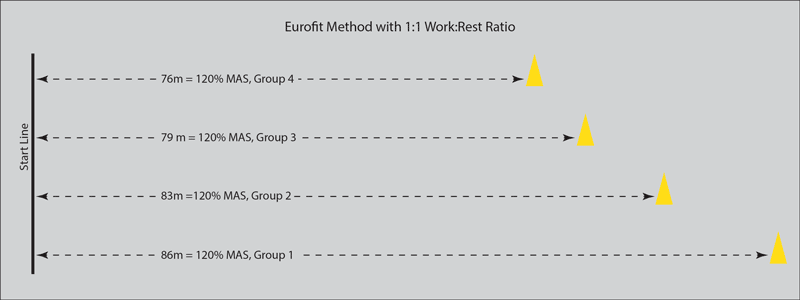

Tabata Method
The original Tabata method is quite exhausting (at 170% VO2 max, % MAS unknown) and is typically only performed for one 4-minute set (14). As field athletes typically must compete for longer time durations, the Tabata protocol has been modified by coaches to be performed at an intensity of ~120% MAS. This allows the set duration to be increased up to 5-, 6- or even 8-minutes and be performed for 2-5 sets, allowing for more time to be spent above the critical 100% MAS intensity.
Figures 3 and 4 detail how this modified Tabata method can be implemented in a smaller area by implementing turns. In this example, the Tabata method is performed as 20 seconds at 120% MAS, done as 10 seconds out, 10 seconds to return, rest 10 seconds and repeat till 5- or more minutes are completed (Figure 3). The turn that occurs in the run makes this speed quite difficult to maintain and more sport specific for field sports. However it may be necessary to use a total distance that is 19-seconds at 120% MAS ~ reduce the distance by the equivalent of 1-s to allow for the deceleration and loss of running velocity involved in the turn. A further variation is to perform the 20-s drill as 5-s out and back, repeated (Figure 4). Turns are thought to increase the anaerobic energy contribution (10).
There may appear to be little difference between the Eurofit and Tabata methods, but the critical difference is the Eurofit is based upon a 1:1 (15-s:15-s) work ratio, whereas the Tabata method utilizes a 2:1 ratio (20s:10s). This apparently minor differential has a pronounced effect upon the accumulation of fatigue when multiple repetitions or sets are performed.
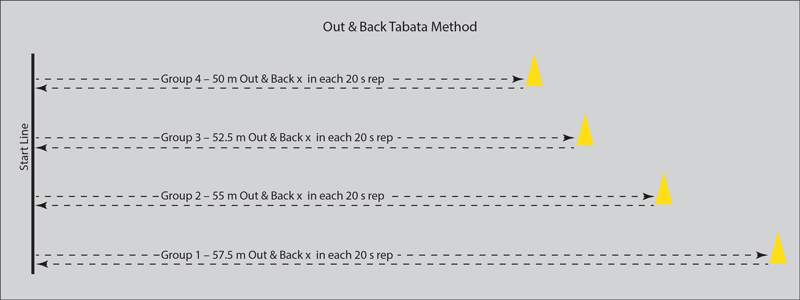
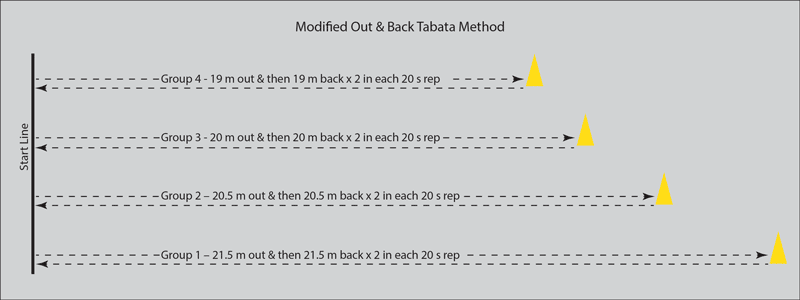

Unpredictable Tabata (or 2:1)
Another variation of the Tabata method is to maintain the 2:1 work/rest ratio and > 120 MAS but alter the length of the intervals to 8:4, 12:6, 16:8 etc.
One of the limitations of all the above conditioning methods is that there are predictable work periods. Athletes quickly adapt to some sort of pacing strategy or know when they are about to start their next effort.
With this second Tabata method the coach can set different coloured cones for each time/distance interval for each group. Upon the “Go” command, the athletes start their effort but not till about 2-seconds after the start are they given the command which will designate which cone they run to and return from. They do not know until that point will they be running to the cone designating 6s out and back, 8s out and back, 16s out and back and so on (see Figure 5). This strategy disrupts running rhythm and recovery strategies, entails reaction to situational commands and causes repeat high-intensity efforts to occur at less predictable times more than any of the other above high-intensity methods.
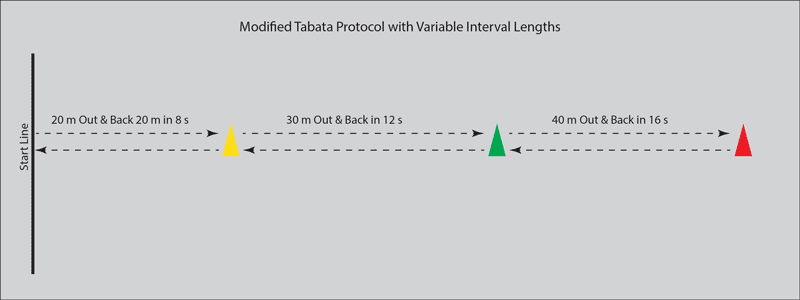
Periodization and progression of training across the Preparation Period
The training methods above have an inbuilt intensity progression as athletes work from < 100% MAS in LI, to 100% MAS in the Grids method to 120 and 130% MAS in the EuroFit and Tabata methods. The other variable for difficulty progression is the choice between the active recovery (at < 40% in LI, to 60-70% MAS in the Grids method) versus the passive rest inherent in the EuroFit and Tabata methods. Furthermore the Tabata method’s work:rest ratio of 2:1 may prove even more difficult as compared to the 1:1 EuroFit method. The second Tabata method with variable interval lengths may prove more even difficult for athletes but this may be due to reasons other than just physiological reasons. Introducing turns in the Tabata, or any method, will also cause an increase in difficulty as this increases the anaerobic contribution (10).
Training can be progressed via the systematic use of all of these different methods, starting with the 3-minute LI’s and reducing LI length to 60-s, then the 100%:70% grids method, moving to the EuroFit 120% MAS method and finishing with the Japanese Tabata methods within a training cycle. Each method can be implemented for 1-3 weeks before progressing to the next method or a weekly cycle can involve a number of methods (see Tables 1 and 2).
Within each 2-3 week mini-cycle, the typical volume progressions would also occur (5-minute sets building up to 8- or even 10-minute sets and/or 2 sets building up to 3 or 4 sets). Consequently when a progression to the new method occurs there is a marked decrease in volume, but an increase in intensity ~ this week serves as a “volume un-load” week (see weeks 4 & 7 in Table 2). Therefore as intensity initially increases with the introduction of the new method, volume is lowest, but builds up over time before implementing the next intensity progression, again with a lower volume.
Once an athlete has attained some training experience with these methods, weekly undulating periodization is also possible with one aerobic training day emphasizing increasing the time spent at ~100% MAS (and possibly also the time of each repetition spent at 100% MAS) via the grids method and the other training day spent emphasizing the time spent well above 100% MAS (ie. The Eurofit or Tabata methods) (See Table 2, Day 1 versus Day 3). This methodology is based around the Supramax methods DEVELOPING new aerobic power and improving the ability to repeat high-intensity efforts and the Maximal method, conditioning the body to SUSTAIN the current 100% MAS for longer periods. This within-week alternation of methods allows the athlete to toggle between milder active recovery (eg. 15 s @ 70% MAS or 90-s @ 40% MAS) and passive recovery (15-s rest).
An example of these progressions appropriate to the General Preparation phase is depicted in Table 2. If the GP phase is only 4-weeks long, then this might be modified such that LI, Grids, EuroFit and then Tabata methods are the predominant (but not only) drill for each week.
| Day 1 – Volume Emphasis | Day 2 – Mixed Emphasis | Day 3 – Intensity Emphasis | |
| Week 1 |
Test MAS – 5min time trial LI – 3-min @ 90% MAS:2-min @40% x 4-reps x 2-sets. Rest 4-mins between sets. |
LI – 2-min @ 93% MAS:2-min @40% x 5-reps x 2-sets. Rest 3-mins between sets. |
LI – 90-s @ 96% MAS:90-s @ 40% x 5-reps x 2-sets. Rest 2-mins between sets. |
| Week 2 |
LI – 3-min @ 92% MAS:2-min @40% x 5-reps x 2-sets. Rest 4-mins between sets. |
LI – 90-s @ 98% MAS:90-s @ 40% x 5-reps x 2-sets. Rest 2-mins between sets. |
Grids 100%:70% x 15:15 x 5-mins x 4-sets. Rest 3-mins between sets. |
| Week 3 |
LI – 3-min @ 94% MAS:2-min @40% x 5-reps x 2-sets. Rest 4-mins between sets. |
LI – 90-s @ 100% MAS:90-s @ 40% x 5-reps x 3-sets. Rest 2-mins between sets. |
Grids 102%:70% x 15:15 x 6-mins x 3-sets. Rest 3-mins between sets. |
| Week 4 |
Retest MAS. Rest 5-mins, then: LI – 60-s @ 100% MAS:60-s @40% x 4-reps x 2-sets. Rest 2-mins between sets. |
Grids 104%:70% x 15:15 x 6-mins x 3-sets. Rest 3-mins between sets. |
EuroFit 120% MAS 15:15 x 12-reps (6-mins) x 2-sets. Rest 3-mins between sets. |
| Week 5 |
Grids 104%:70% x 15:15 x 8-mins x 2-sets. EuroFit 120% MAS 15:15 x 14-reps (7-mins) x 2-sets. Rest 3-mins between sets. |
EuroFit x 1-set (7-mins) Grids x 1-set (7-mins) LI – 60-s:60-s x 4 (8-mins) Rest 3-mins between sets. |
Tabata x 120% MAS x 20:10 x 10-reps x 3-sets. Rest 3-mins between sets. |
| Week 6 |
Grids 105%:70% x 15:15 x 8-mins x 2-sets. EuroFit 125% MAS 15:15 x 16-reps (8-mins) x 2-sets. Rest 3-mins between sets. |
Tabata x 120% MAS x 20:10 x 8-reps x 2-sets EuroFit x 120% MAS x 20:20 x 8-reps x 2-sets Rest 3-mins between sets. |
Tabata 125% 20:10 x 10 x 1-set Unpredictable Tabata 5- to 6-min set x 2-sets. Rest 3-mins between sets. |
| Week 7 |
Grids 103%:70% x 15:15 x 8-mins x 2-sets. EuroFit 125% MAS 15:15 x 16-reps (8-mins) x 2-sets. |
EuroFit x 120% MAS x 20:20 x 8-reps SSG x 1 (8-mins) EuroFit x 120% MAS x 20:20 x 8-reps SSG x 1 (8-mins) Rest 2-mins between sets. |
Tabata x 1 (5-mins) SSG x 1 (5-mins) Unpredictable Tabata (5-mins) SSG x 1 (5-mins) Rest 2-mins between sets. |
| Week 8 |
Tetest MAS End of General Preparation |
Integrating high-intensity aerobic training with sports training and small-sided games (SSG)
The limitation of the above methods is that there is still some ‘predictability” about them. Field sports often require intense efforts at unpredictable times and hence some researchers and coaches have advocated small sided games as a better alternative to traditional conditioning due to the “unpredictability” of games and the fact that games also develop sports skills and game sense. However the overload delivered by games by themselves is also unpredictable and depends upon the structure and rules of the games etc. I have data from that shows the athletes with the highest MAS covered the most meters in each SSG and had the most winning outcomes, so how would SSG improve those athletes with lower MAS scores?
My recommendation is that almost all athletes below the elite or professional level are better suited to using traditional conditioning methods as described above to develop greater MAS and fitness levels in the General Preparation phase, rather than relying on small sided games to develop aerobic fitness.
So what role do SSG play? For the elite performer, with GPS technology to monitor running workloads in real-time, plenty of assistant coaches watching, high motivation levels etc, SSG are great. But athletes below that elite level?
My experience has shown that conditioning-oriented SSG become more effective after the GP phase, once fitness levels have been established. Once a field sport athlete has attained an adequate MAS and is in the Specific Preparation phase or Competitive Periods of the sport season, then skill and tactical training must takes precedence. It is during the Specific Preparation phase that the alternating of 4-8 minute sets of the above conditioning drills with 3-8 mins of small-sided games is an effective conditioning/maintenance and sports skill development tool for field sport athletes.
As mentioned earlier typically skills are coached in relatively low stress situations (low heart rate, minimal fatigue, less than full speed or full-force opposition) which are fine for the initial skill development and tactical learning situations – the polarity of training readily suitable for GP training. But does this type of training enhance the skill or tactical sports performance of advanced athletes or mimic the game situations?
I find it akin to a fighter only hitting the heavy bag or the trainer’s pads and expecting to fight well in competition. Everyone looks good hitting the pads, but in real life competitive fighting situations, getting punched in the face alters everything, so sparring must be done in training! And must be done in a fatigued state on occasions.
So my recommendation is to utilize the above conditioning drills, conditioning-oriented SSG or game-scenario simulation SSG and lower intensity skills together in the SP phase and In-season periods. The authors’ experience is that the fatigue resulting from the performance of the above conditioning drills allows the head skill/sports coach to see fatigue related breakdowns in 1) individual skill technique, 2) decision-making or 3) inability to match the game speed, resulting in the effective dismantling of the teams’ defensive or offensive structure/patterns/formation the during ensuing skill- and small-sided games.
Typically these three types of “breakdown” occur in the most fatiguing parts of real competition games but are not so well illuminated to the athlete or coach during “normal” lower intensity skill or tactical training sessions which are practiced in less fatiguing or stressful situations. Thus the head skill/sports coach can develop and implement intense small-sided games that challenge or illustrate which of these types of breakdowns occur (and to which athletes) for different critical game scenario situations.
So the S & C coach pre-fatigues the athletes so the coach can implement game situation simulation drills or SSG’s to see if there are any of the three “break-downs” and to whom.
It has been the author’s experience that the following combination of a 6-minute supra-maximal 120% MAS drill (e.g. Tabta or EuroFit), followed by a 6-minute SSG and a 3-minute semi-passive recovery (eg. stationary passing and catching of balls) without rest is very challenging to the athlete’s fitness and individual skill levels. When this is again followed by another 5 to 8-minute conditioning set and another SSG not only is the athlete’s aerobic and anaerobic conditioning and skill levels challenged but it may also display the athlete’s ability to maintain appropriate decision making and team structure during the second small sided game. An example of the Specific Preparation phase integration of conditioning sets, SSG, skill and tactical training is displayed in Table 3. In this training session, the goal would be for 30% of the total distance covered (excluding warm-up) to be performed at a speed above 4 m/s.
| Time Allocation | Drill | Objective |
| 0-6 mins | Movement preparation drills. | Prepare the body for training. |
| 7-15 mins | Running technique drills. | Reinforce running mechanics and increase the intensity of the latter warm-up period. |
| 15-17 mins | Drink break & rest. | |
| 17-27 mins | Skills & small group tactics. | Breaking into smaller groups, familiarization with the skills, tactics and drills that are the focus of the session, in a non-fatigued state before the main portion of the session. |
| 27-30 mins | Drink break & rest. | |
| 30-35 mins | Tabata 120% MAS x 20:10 x 10. | Induce fatigue and maintain MAS fitness levels. |
| 35-42 mins | Small-sided conditioning game. | Reinforce the skills and tactics that are the focus of the session in fatigued, competitive situations. |
| 42-45 mins | Stationary skills. | Practice basic stationary skills (eg. passing, catching, kicking etc) proficiency in a fatigued state. |
| 45-48 mins | Drink break & rest. | |
| 48-55 mins | Eurofit @120% x 15:15 x 14. | Induce fatigue and maintain MAS fitness levels. |
| 55-62 mins | Small-sided conditioning game. | Reinforce the skills and tactics that are the focus of the session in fatigued, competitive situations. |
| 62-65 mins | Stationary skill. | Practice basic stationary skills (eg. passing, catching, kicking etc) proficiency in a fatigued state. |
| 65-68 mins | Drink break & rest. | |
| 68-83 mins | Team tactical training. | Practice broader team tactics with attention to the skills and small group tactics reinforced earlier. Look for fatigue related break-downs in team structure of individual skill levels. |
| 83-90 mins | Warm-down and de-brief. |
General Preparation versus Specific Preparation and high-intensity conditioning
By analysing Tables 2, it can clearly seen that the early General Preparation phase has more time devoted to basic training of energy system fitness. In comparison, Table 3, which outlines a Specific Preparation phase training session has only 1 x 5-minute set and 1 x 7-minute set specifically devoted to the above conditioning drills out of a total of 90-minutes.
So the basic summary is, in the GP spend more time improving MAS and allied energy system fitness with the above mentioned drills while the skill and tactical training is done at low intensity to ensure good learning. As fitness improves across the weeks, the amount of time spent performing conditioning decreases but the intensity of the conditioning drills and the skill/tactical training increases. By the time of SP, only a short amount of time needs to be spent performing specific high-intensity drills and they should be integrated with SSG and skill/tactical training.
Accordingly, in the SP or In-season, high-intensity aerobic conditioning drills can be seen as part of an integrated and coherent sports performance enhancement program that aids in the development or display of skills under challenging game simulation situations.
Conclusions
Experienced field sport athletes gain little in terms of enhancing their aerobic power from LSD training such as road runs at < 80% MAS etc. Training at or above 100% MAS has been shown to be more effective. The methods presented can be implemented in a progressive manner across a General Preparation Period.
The LI’s and Grids maximal methods outlined are thought to best condition athletes to be able to sustain high-intensity aerobic power for longer periods, which can occur with many field sports. The two supra-maximal methods are believed to be best for developing new levels of high-intensity aerobic power or to be able to repeat their high-intensity efforts.
Once an athlete is in the Specific Preparation Phase or In-season Period, total training duration devoted to high-intensity conditioning can be quite short ~ (eg. 1-3 sets of 4-10-minutes duration) and combined and integrated with small-sided games or skill and tactical training. This integration of training is highly recommended for field sport athletes to develop skill and tactical nous under fatigue and stressful situations akin to the real competitive environment.
Since you’re here…
…we have a small favor to ask. More people are reading SimpliFaster than ever, and each week we bring you compelling content from coaches, sport scientists, and physiotherapists who are devoted to building better athletes. Please take a moment to share the articles on social media, engage the authors with questions and comments below, and link to articles when appropriate if you have a blog or participate on forums of related topics. — SF
[mashshare]
References
1. Baker, D. Recent trends in high-intensity aerobic training for field sports. Professional Strength & Conditioning. 22 (Summer): 3-8. 2011.
2. Baker, D. Cross-training workout: using high-intensity energy system conditioning for injured athletes. Professional Strength & Conditioning. 27 (Winter): 4-8. 2012.
3. Baker D. Non-running, high-intensity energy-system conditioning cross-training workouts for injured athletes. Journal of Australian Strength & Conditioning 21(4)5-13. 2013.
4. Baker, D. & N. Heaney. Some Normative Data for Maximal Aerobic Speed for Field Sport Athletes: A Brief Review. Journal of Australian Strength & Conditioning (in review).
5. Baquet, G, Berthoin S, Gerbeaux M and Van Praagh E. High-intensity aerobic training during a 10-week one-hour physical education cycle: Effects on physical fitness of adolescents aged 11 to 16. International Journal of Sports Medicne. 22:295–300. 2001.
6. Berthoin S, Manteca F, Gerbeaux M and Lensel-Corbeil G. Effect of a 12-week training program on maximal aerobic speed (MAS) and running time to exhaustion at 100 percent of MAS for students aged 14 to 17 years. Journal of Sports Medicine & Physical Fitness. 35:251–256. 1995.
7. Berthon, P., Fellmann, N. Bedu, M., Beaune, B., Dabonneville, M., Coudert , J., and A. Chamoux. A 5-min running field test as a measurement of maximal aerobic velocity. European journal of Applied Physiology. 75: 233–238. 1997.
8. Berthoin S, Gerbeaux, M, Geurruin F, Lensel-Corbeil G and Vandendorpe F. Estimation of maximal aerobic speed. Science & Sport 7(2), 85-91. 1992.
9. Billat, V and Koralsztein. JP. Significance of the velocity at O2max and time to exhaustion at this velocity. Sports Medicine. 22:90–108. 1996.
10. Buchheit, M. The 30-15 Intermittent Fitness Test: Accuracy for individualizing interval training of young intermittent sport players. Journal of Strength & Conditioning Research. 22(2):365-374. 2008.
11. Castagna, C., Barbero Á. and J. Carlos. Physiological demands of an intermittent Futsal-oriented high-intensity test. Journal of Strength & Conditioning Research. 24(9):2322-2329. 2010.
12. Dupont, G., K. Akakpo, and S. Berthoin. The effect of in-season, high-intensity interval training in soccer players. Journal of Strength & Conditioning Research. 18(3):584–589. 2004.
13. Dupont, G., N. Blondel, G. Lensel, and S. Berthoin. Critical velocity and time spent at a high level of O2 for short intermittent runs at supramaximal velocities. Canadian Journal of Applied Physiology. 27:103–115. 2002.
14. Tabata I, Nishimura K, Kouzaki, M, Hirai Y, Ogita, F, Miyachi M and Yamamoto K. Effects of moderate-intensity endurance and high intensity intermittent training on anaerobic capacity and VO2 max. Medicine & Science in Sports & Exercise. 28:1327–1330. 1996.
15. Wong, P-L, Chaouachi, A, Chamari, K, Dellal, A, and Wisloff, U. Effect of preseason concurrent muscular strength and high-intensity interval training in professional soccer players. Journal of Strength & Conditioning Research. 24(3): 653-660. 2010.




